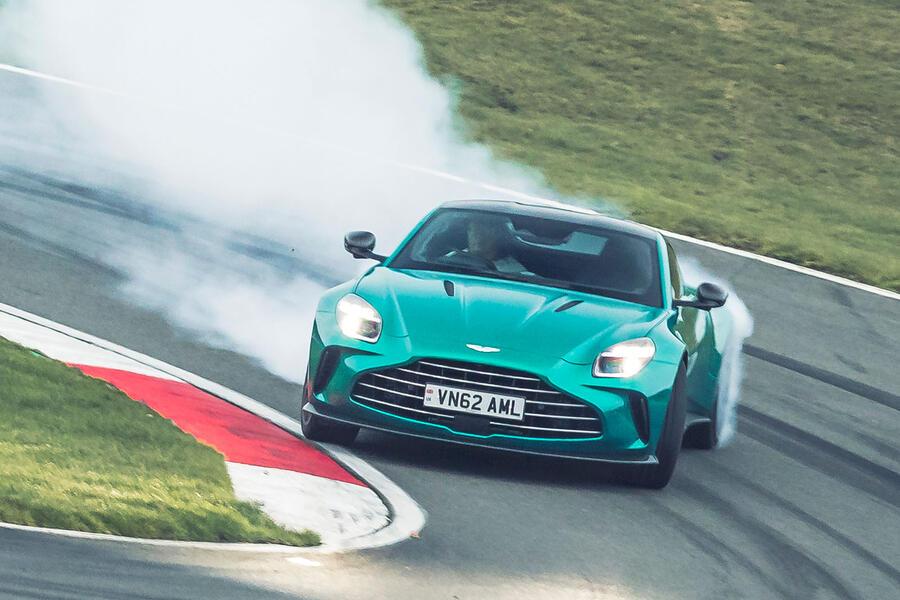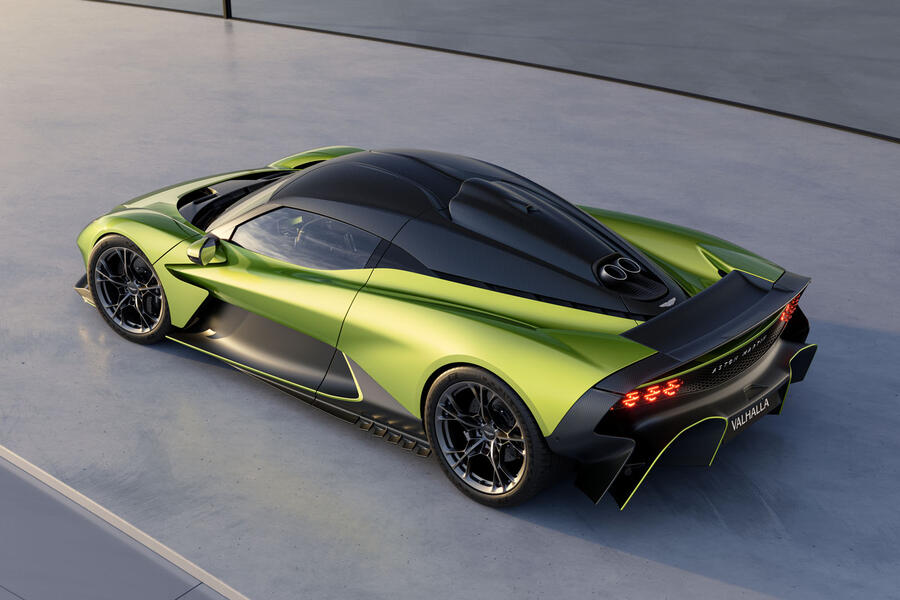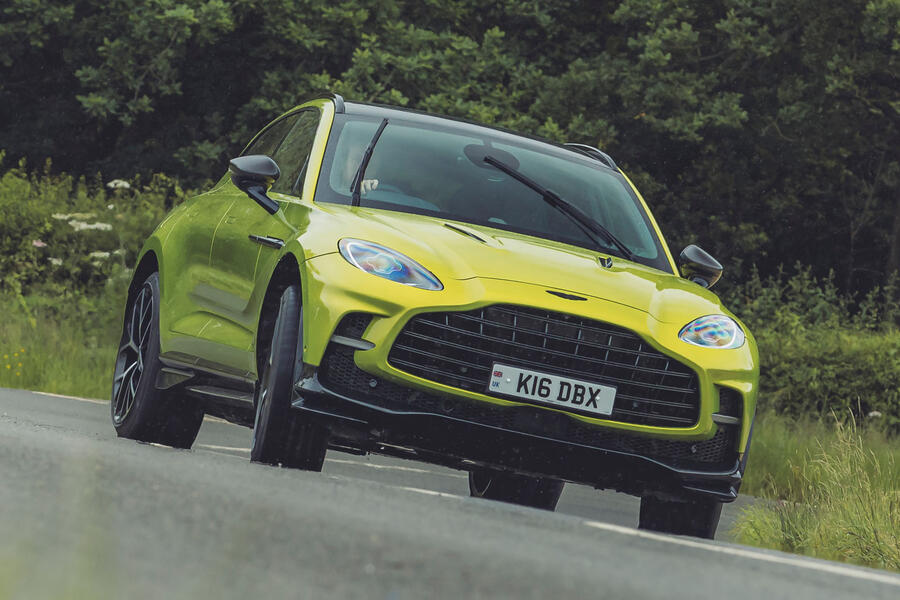Aston’s first EV – here imagined by Autocar – was previously planned for 2027
New boss Adrian Hallmark outlines plans for the future, including mid-engined investment and a push for the DBX
Aston Martin will rapidly expand its hybrid line-up and increase the number of model variants it offers in the coming years, according to new boss Adrian Hallmark – and it will launch its first electric vehicle before the end of this decade.
Former Bentley boss Hallmark took over as CEO of the sports car firm in September last year and has been working on a revised strategy for the coming decade.
Hallmark said he had been tempted into joining Aston because it was “an amazing brand” with “great potential, great shareholders and investment for the future, and a product portfolio we have never had before and couldn’t have dreamed of”.
The dramatic growth in the number of luxury car buyers in recent years has expanded Aston’s market potential, he said, and the key to its future success is that “the plan has got to be boring and stable. You can create the excitement around you, but you don’t create excitement by ripping the plan up every five minutes.”
The challenge of Aston
Hallmark had been in his previous role at Bentley since 2018, and said he “loved” working for the company. But he added: “This opportunity came alone, and the chance to be the first person in 112 years to make it sustainably profitable, when I believe there is a way to do so, was irresistible.”
Speaking to a select group of reporters, including Autocar, Hallmark said he is confident he can achieve that target “because we’ve got the playbook, not just from Bentley but all the luxury players that are out there.
“In the last 10 to 15 years, the market has totally changed, and so have the prospects for luxury car markers. If you go back 10 or 20 years, the number of people that would buy products in our price bracket was a fraction of that it is today. Both the number and average wealth of luxury buyers has increased fourfold, so the market for luxury has exponentially increased – and the opportunities for companies like Aston Martin have matched that.”
Hallmark said he was also attracted to Aston by the investment made in the firm since it was taken over by a consortium led by Lawrence Stroll four years ago. He added: “There’s no way in my old world, with any of the brands I’ve worked directly or indirectly for in the last 25 years, [they] would have tried a product offensive like Aston did over the last 18 months [with the launch of the DB12, Vantage, Vanquish, Valkyrie, Valhalla and several specials].
“It almost worked, but not every car was perfect day one, and there’s been delays, but the ambition and the spend is all genuine. It’s not any difficulties we’ve had, and not because of lack of money. This is a genuine endeavour and the commitment to make a high-potential company a high-performance one is there.”
Electrification plans
Previous Aston management touted plans to use plug-in hybrid powertrains as a ‘transitional’ technology on the firm’s path to electrification. The forthcoming mid-engined Valhalla will be Aston’s first plug-in hybrid model, but the firm has a partnership to use PHEV technology developed by Mercedes-AMG for other models.
Hallmark said the electrification pathway is “not as clear-cut as three or five years ago, but the general direction is absolutely towards electrification. Our commitment is towards carbon-neutral or net zero. But to get there we will double down and add incremental products in the hybrid space before we get to full electric.”
Nevertheless, Hallmark insisted Aston’s first EV will arrive “in this decade, but we’ll add hybrid derivatives as well, through to 2035”. Previous management had set a date of 2027 for the first EV but Hallmark said he had questioned that even before starting his role and he refused to be drawn on a specific date.
He added that “we have all the prerequisites defined, and some of them developed” for the first EV models. Aston has a deal to use US EV firm Lucid’s electric motor, battery control systems and inverters for its EVs.
Asked by Autocar whether the first EV will be a new model or a variant of an existing one, Hallmark said: “For a company of our size, you have to either replace an existing nameplate and take the brave pill, or create the niche [and do] an incremental model as the first one. We haven’t fully decided. The original plan was to go with an incremental model, but we’re looking to other options.”
The approach is about being “flexible” over the next 10 years, said Hallmark, adding: “The key message will be to be flexible and have multiple options that fit with legislative and customer requirements over that period.”
Hallmark said he expects combustion models “with some form of electrification” to account for the bulk of sales until 2030, with the firm eventually becoming “full electric some time between 2035 and 2040”.
He said: “We’re not resisting. We’re just taking account of legislation and trying to manage through a period of high risk for a small company. We can’t afford to do engines, hybrids and electric cars and just see which ones work and then turn off the factories of the others.”
Consolidation

Hallmark joined Aston shortly after one of the biggest product offensives in its history, including the new DB12, Vantage and Vanquish, along with the Valkyrie hypercar. Hallmark said he had “never seen as much ambition in 18 months”.
He acknowledged that the rollout of those models hadn’t been as smooth as anticipated due to that compressed cycle and he hinted that, EV aside, further new model lines won’t arrive until after 2030. Instead, the focus will be on maximising the potential of the brand’s existing models.
Hallmark said Aston’s limited provision of model variants means it risks existing buyers going elsewhere. He cited the example of Porsche, which offers numerous variants of the Vantage-rivalling 911.
“At the moment, customers buy a Vantage, DB12 or DBX and keep it for two years or so, which is the average ownership cycle in the luxury segment,” said Hallmark. “So in two years’ time, there’s got to be a reason to buy a better Vantage, and then two years after that an even better Vantage. We’ve never had the intensity of life-cycle innovation that we need, and if our competition are doing it and we’re not, we’ll never be as successful as we could.”
This approach will include substantially expanding the list of high-end options, after Aston found that some rivals were offering close to 200 more options and extras than it was. While he said not all those were relevant to a performance brand, he said Aston had identified around 100 options that could be added to its range – “titanium exhaust, carbon wheels, high-end audio and so on” – to add further value.
Hallmark said: “If we can add those and have normal levels of uptake, the per-year improvement in our bottom line, and more importantly the fit in meeting customer needs, is massive.”
Mid-engined cars

As part of its luxury push to rival Ferrari, Aston has moved into the mid-engined supercar sphere in recent years, with the Adrian Newey-designed Valkyrie and the upcoming Valhalla.
Newey now works for Aston’s F1 team, and while Hallmark didn’t rule out an eventual Valkyrie successor, he said developing that sort of boundary-pushing model is “a once in a seven- or 10-year cycle” project. He added: “Not many car companies can afford, financially or emotionally, to do a car that is so far ahead of themselves and everybody else every year. It would kill you.”
He was non-committal on a Valhalla successor, suggesting its platform can’t be used for a lower-priced version.
“If I look at the second half of this 10-year period, this is all about the acceleration of the launch of BEVs and the redefinition of the core portfolio,” he said. “There’s no question that if we want to be a high-performance sports car brand as well as what would be in the past, then mid-engine is attractive.
“Valhalla is too sophisticated a platform in totality to make an affordable mid-engine car, so it would mean a completely new platform, and we haven’t defined that yet. It’s not off the cards, but it’s not defined.”
Hallmark also cited the profitability of ultra-limited-run specials in the luxury market and said both the Valhalla and front-engined Vanquish will be used “as the basis to do a couple of specials”, but he added: “We’re not going to go specials crazy in terms of overdoing it, because there is a finite market for these cars as well.”
He hinted that those specials will “not just have a different roof” from their base car, but will be “a completely different concept, but using the core technologies from those two.”
Faith in the DBX

Hallmark is confident the DBX SUV will eventually succeed, despite lower than expected sales so far. He compared it to Bentley’s struggles with the Bentayga in the first few years after its launch and said there is still work to do on raising awareness of the model.
“In 2018 the Bentayga was seen as a failure that was selling 3500 to 4000 cars per year, but there was a little facelift and a lot of communication and it was selling nearly 8000 in 2023,” said Hallmark.
“Not everybody knows we’ve got a DBX. If you go to America and look at the awareness of the brand and then the products, only around 40% of luxury buyers know we even do an SUV. We launched the DBX during Covid, and we’ve got a problem in that it was launched in a strange way.
“We had a position for the car we’ve subsequently changed, and [we changed] the pricing as well. But I fundamentally believe that if 52% of the luxury segment is SUV, then we need an SUV. [The DBX] hasn’t done everything it needs to do yet.
“Watch this space in the next one to three years. We’re going to attack through the life cycle, and give people reasons to come back or come to us. We want to keep the strength we have with two-door cars and boost the exotic nature of the Valhalla. We will keep that sports car, supercar, hypercar story moving nicely, but we can and will make the SUV work – because it’s a brilliant car.”
Sales targets
Late last year, Hallmark scaled back Aston’s planned 2024 production output by 1000 units to around 6000 units and it lags behind rivals, such as Ferrari, that produce closer to 13,000 cars annually.
Asked about Aston’s goals, Hallmark said: “Look at the Luca di Montezemolo [former boss] period at Ferrari: there was this repeated rule they would never go above 7000 cars, and look how much money they made on 7000 cars.
“We’ve never made that much money, and I’m not saying our limit is 7000 cars, but we don’t need 13,000 cars to be a great company. What we need is the right margins, the right volume of cars and the right cost base. What you’ll see in the next period is volume, no question, but you’ll also see us addressing the productivity and cost structure of the company.”


